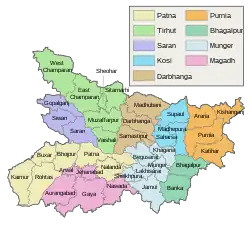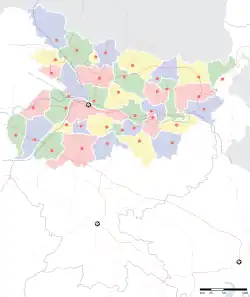 Seal of Bihar | |
| Seat of Government | Patna |
|---|---|
| Legislative branch | |
| Assembly | |
| Speaker | Awadh Bihari Chaudhary |
| Members in Assembly | 243 |
| Council | Bihar Legislative Council |
| Chairman | Awadhesh Narain Singh |
| Members in Council | 75 |
| Executive branch | |
| Governor | Rajendra Vishwanath Arlekar |
| Chief Minister | Nitish Kumar |
| Judiciary | |
| High Court | Patna High Court |
| Chief Justice | Justice Shri k vinod chandran |
Bihar is a state situated in Eastern India. It is surrounded by West Bengal to the east, Uttar Pradesh to the west, Jharkhand to the south and Nepal to the north.
History
Magadha, Anga and Vajjika League of Mithila, c. 600 BCE.
Bengal Presidency
Before 1905, Bihar was a part of British East India Company's Bengal Presidency. In 1905 the Bengal Presidency was divided and created two new provinces: East Bengal and West Bengal. Until then Bihar was part of West Bengal. Again West Bengal and East Bengal reunited in 1911 but the people of Bihar and Orrisa demanded a separate province based on language rather than religion. In 1912 Bihar and Orissa Province was created separating from Bengal Presidency. In 1936, Bihar and Orrisa Province divided into two new provinces: Bihar Province and Orissa Province.
Bihar and Orissa Province
Following Divisions were included in Bihar and Orissa Province when it separated from Bengal Presidency in 1912:
- Bhagalpur Division (districts of Bhagalpur, Munger (Monghyr), Purnea and the Sonthal Parganas)
- Patna Division (Gaya, Patna and Shahabad)
- Tirhut Division (Champaran, Darbhanga, Muaffarpur and Saran)
- Chota Nagpur Division (Hazaribagh, Manbhum, Palamau, Ranchi and Singhbhum)
- Orissa Division (Angul, Balasore, Cuttack, Puri and Sambatpur)
On 1 April 1936 Bihar and Orissa Province was divided into two new provinces: Bihar Province and Orissa Province
Bihar Province
In 1936, Bihar became a separate province including part of Jharkhand.
After the independence of India in 1951, Bihar including Jharkhand had 18 divisions, and had 55 districts in 1991.
Bihar
In 2000, Bihar again divided into two states: the current Bihar and Jharkhand. In 2001 Bihar had a total of 38 districts.
Administrative structure
Structure
| Divisions | 9 |
|---|---|
| Districts | 38 |
| Subdivisions | 101 |
| Cities and towns | 261 |
| Blocks | 534 |
| Villages | 45,103 |
| Panchayats | 8,058 |
| Police Districts | 43 |
| Police Stations | 1064 |
Structurally Bihar is divided into divisions (Pramandal), districts (Zila), sub-divisions (Anumandal) & circles (Aanchal).The state is divided into 9 divisions, 38 districts, 101 subdivisions and 534 circles.[1] 17 municipal corporations, 84 Nagar Parishads and 151 Nagar Panchayats,[2][3][4][5][6] for administrative purposes.
| India | |||||||||||||||||||||||||||||||||||
| Bihar | |||||||||||||||||||||||||||||||||||
| Divisions | |||||||||||||||||||||||||||||||||||
| Districts | |||||||||||||||||||||||||||||||||||
| Blocks (Tehsils) | Municipal Corporations (Nagar Nigam) | Municipal Councils (Nagar Parishad) | Town Council (Nagar Panchayat) | ||||||||||||||||||||||||||||||||
| Villages (Graam/Gau'n) | Wards | ||||||||||||||||||||||||||||||||||
Divisions and Districts
There are 38 districts in Bihar, grouped into 9 divisions —Patna, Tirhut, Saran, Darbhanga, Kosi, Purnia, Bhagalpur, Munger and Magadh —are as listed below.
| Division | Headquarters | Districts | District map of Bihar |
|---|---|---|---|
| Patna
|
Patna | Bhojpur, Buxar, Kaimur, Patna, Rohtas, Nalanda |  |
| Saran | Chapra | Saran, Siwan , Gopalganj | |
| Tirhut | Muzaffarpur | East Champaran, Muzaffarpur, Sheohar, Sitamarhi, Vaishali, West Champaran | |
| Purnia | Purnia | Araria, Katihar, Kishanganj, Purnia | |
| Bhagalpur | Bhagalpur | Banka, Bhagalpur | |
| Darbhanga | Darbhanga | Darbhanga, Madhubani, Samastipura | |
| Kosi | Saharsa | Madhepura, Saharsa, Supaul | |
| Magadh | Gaya | Arwal, Aurangabad, Gaya, Jehanabad, Nawada | |
| Munger | Munger | Begusarai,Jamui, Khagaria, Munger, Lakhisarai, Sheikhpura |
Sub-divisions
Sub-divisions (Anumandal) in Bihar are like sub-districts. There are 101 subdivisions in Bihar.
Blocks
The Indian state of Bihar is divided into 534 CD Block called blocks.[7][8]
List of Blocks in Bihar
| District | Block |
|---|---|
| Gaya | Gurua |
| Gaya | Konch |
| Gaya | Manpur |
| Gaya | Paraiya |
| Gaya | BankeBazar |
| Gaya | Imamganj |
| Gaya | Dumariya |
| Gaya | Barachatti |
| Gaya | wazirganj |
| Gaya | Sherghati |
| Gaya | Tekari |
| District | Block |
|---|---|
| Nawada | Akbarpur |
| Nawada | Govindpur |
| Nawada | Hisua |
| Nawada | Kashichak |
| Nawada | Kawakol |
| Nawada | Meskaur |
| Nawada | Nardiganj |
| Nawada | Narhat |
| Nawada | Nawada |
| Nawada | Pakribarawan |
| Nawada | Rajauli |
| Nawada | Roh |
| Nawada | Sirdala |
| Nawada | Warisaliganj |
| District | Block |
|---|---|
| Begusarai | Chhourahi |
| Begusarai | Balia |
| Begusarai | Mansurchak |
| Gopalganj | Kuchaikote |
| Jehanabad | Hulasganj |
| Purnia | Bhawanipur |
| Saran | Dariapur |
| Saran | Sonpur |
| Sitamarhi | Majorganj |
| Munger | Dharhara |
| Muzaffarpur | Sahebganj |
Urban Local Government
Municipal Bodies
As per Census 2011, Bihar is the second least urbanised state in the country, with a rate of urbanisation of 11.3%, as compared to the national rate of 31.16%.[9][10] The state has 139 StatutoryTowns and 60 Census Towns.[11]
For the administration of the urban areas, Bihar has 19 municipal corporations, 88 nagar parishads (city councils), and 154 nagar panchayats (town councils).[12][13][14][15][16] Bihar has one municipal act to establish and govern all municipalities in the state: Bihar Municipal Act, 2007.[17]
As per a 2017 report by the Comptroller and Auditor General of India, Urban Local Bodies (ULBs) in Bihar carry out 12 out of 18 functions, and the remaining 6 are carried out by Bihar state government departments.[18] The Fifth Bihar State Finance Commission report states that the ULB funds are ‘grossly inadequate for their assigned functions, they are unable to utilize even that’.[19]
The Bihar Municipal Act, 2007 creates the following categories of urban areas based on their population. All three types of urban areas must have at least 75% of their population engaged in non-agricultural work.[17]
| Types of Urban Areas according to the Bihar Municipal Act, 2007 | ||
| Type | Population Criteria | Type of Local Body |
| City | Larger urban area: 2 lakh or more | Municipal Corporation |
| Town | Medium urban area: 40 thousand or more but less than 2 lakh | Municipal Council |
| Small Town or Transitional Area | 12 thousand and more
but less than 40 thousand |
Nagar Panchayat |
Further, depending on the population size, the Act prescribes the minimum and maximum number of councillors/wards allowed within each type of local government.
| Minimum and Maximum number of Councillors/Wards Allowed according to the Bihar Municipal Act, 2007 | |||
| Population Range | Minimum | Incremental Number | Maximum |
| Municipal Corporations | |||
| Above 10 lakh | 67 | One additional Councillor for every 75,000 above 10
lakh |
75 |
| Above 5 lakh up to 10 lakh | 57 | One additional Councillor for every 50,000 above 5
lakh |
67 |
| Above 2 lakh up to 5 lakh | 45 | One additional Councillor for every 25,000 above 2
lakh |
57 |
| Municipal Council | |||
| Class 'A' Municipal Council | 42 | One additional Councillor for every 15,000 above
1,50,000 |
45 |
| Class 'B' Municipal Council | 37 | One additional Councillor for every 10,000 above 1
lakh |
42 |
| Class 'C' Municipal Council | 25 | One additional Councillor for every 5,000 above
40, 000 |
37 |
| Nagar Panchayat | |||
| Nagar Panchayat | 10 | One additional Member for every 2,000 above 12,000 | 25 |
The Act mentions the following key positions as well as committees for ULBs:
| Elected Officials | Administrative Officials | Committees |
| Councillor, Chief Councillor, Deputy Chief Councillor | Municipal Commissioner, Controller of Municipal Finances and Accounts, Municipal Internal Auditor, Chief Municipal Engineer, Municipal Architect and Town Planner, Chief Municipal Health Officer, Municipal Law Officer, Municipal Secretary, three Additional Municipal commissioners
Such number of Joint Municipal Commissioners or Deputy Municipal Commissioners or Deputy Chief Municipal Engineers as the Empowered Standing Committee may, from time to time, determine, |
Empowered Standing Committee, Joint Committee, Municipal Accounts Committee, Subject Committee, Ward Committee, Wards Committee |
Ward Committees
Bihar Municipal Act, 2007 mandates the establishment of Ward Committees through the Bihar Urban Local Body (Community Participation) Rules, 2013.[20] Section 31 of the Bihar Municipal Act, 2007 mandates the establishment of Ward Committees for each ward of a municipality.[17] The ward level elected councillor would be the chairperson of their respective Ward Committee. Up to 10 representatives from the civil society belonging to the ward would be nominated into the committee by the ULB.
Even though the creation of ward committees is mandated in municipalities, they have not been formed in Bihar.[21]
Government
Like other states in India, the head of state of Bihar is the Governor, appointed by the President of India on the advice of the central government. His or her post is largely ceremonial. The Chief Minister is the head of government and is vested with most of the executive powers. Patna is the capital of Bihar.
The Patna High Court, located in Patna, has jurisdiction over the whole state. The present legislative structure of Bihar is bicameral. The Legislative houses are the Bihar Vidhan Sabha (Bihar Legislative Assembly) and Bihar Vidhan Parishad (Bihar Legislative Council). Their normal term is five years, unless dissolved earlier.
Legislature
Bihar is one of the six states where bicameral legislature exists. Other states are Uttar Pradesh, Karnataka, Maharashtra, Telangana and Andhra Pradesh. The Vidhan Parishad serves as the upper house and Vidhan Sabha serves as the lower house of a bicameral legislature. The current strength of the Bihar Vidhan Parishad is 75 (63 Elected + 12 Nominated) is a permanent body. The current strength of the Bihar Vidhan Sabha is 243 and is not a permanent body which means it is subject to dissolution.
Judiciary
High court
The Patna High Court (Hindi: पटना उच्च न्यायालय) is the High Court of the state of Bihar and was established on 9 February 1916 and later affiliated under the Government of India Act 1915. The Patna High Court is the principle civil courts in Bihar. However, a high court exercises its original civil and criminal jurisdiction only if the subordinate courts are not authorized by law to try such matters for lack of pecuniary, territorial jurisdiction. High courts may also enjoy original jurisdiction in certain matters, if so designated especially in a state or federal law. The Patna High Court has 53 Judges which includes 40 permanent and 13 additional judges.
City Courts
See also
References
- ↑ "Indexing Gender Parity and Estimation of Child Marriage: A comprehensive study of 534 Blocks in Bihar". Archived from the original on 2017-09-25.
- ↑ "Bihar Civic elections likely in May 2017". Archived from the original on 2017-03-31.
- ↑ "बिहार : नगर विकास एवं आवास विभाग की पहल, पुनर्गठन से नगर परिषदों की बढ़ जायेगी संख्या". Archived from the original on 2017-03-24.
- ↑ "पहली बार कोई महिला बनेगी पटना नगर निगम की मेयर". Archived from the original on 2017-03-24.
- ↑ "Ward delimitation begins in Chhapra". Archived from the original on 2017-02-27.
- ↑ "छपरा को निगम बख्तियारपुर को मिला नगर परिषद का दर्जा". Archived from the original on 2017-03-24.
- ↑ "State Profile". Government of Bihar. Archived from the original on 6 July 2017. Retrieved 6 July 2017.
- ↑ "534 Bihar Blocks list" (PDF). Archived (PDF) from the original on 2017-08-28.
- ↑ Ranjan, Sagarika (8 February 2016). "The challenge of urbanizing Bihar". Governance Today. Retrieved 24 August 2020.
- ↑ "Provisional Population Totals: Urban Agglomerations and Cities" (PDF). Census India. Retrieved 24 August 2020.
- ↑ "Provisional Population Totals: Bihar" (PDF). Census India. Retrieved 24 August 2020.
- ↑ "Bihar Civic elections likely in May 2017". Archived from the original on 31 March 2017. Retrieved 30 March 2017.
- ↑ Pandey, Ashutosh Kumar (20 March 2017). "बिहार : नगर विकास एवं आवास विभाग की पहल, पुनर्गठन से नगर परिषदों की बढ़ जायेगी संख्या" [Bihar: Initiatives of the Department of Urban Development and Housing, will increase the number of city councils by restructuring]. Prabhat Khabar (in Hindi). Archived from the original on 24 March 2017. Retrieved 19 February 2019.
- ↑ "पहली बार कोई महिला बनेगी पटना नगर निगम की मेयर" [For the first time, a woman will become the mayor of Patna Municipal Corporation]. Archived from the original on 24 March 2017. Retrieved 24 March 2017.
- ↑ "Ward delimitation begins in Chhapra". Archived from the original on 27 February 2017. Retrieved 24 March 2017.
- ↑ "छपरा को निगम बख्तियारपुर को मिला नगर परिषद का दर्जा". 14 February 2017. Archived from the original on 24 March 2017. Retrieved 24 March 2017.
- 1 2 3 "Bihar Municipal Act, 2007" (PDF). Urban Development and Housing Department, Government of Bihar. Retrieved 24 August 2020.
- ↑ "Report of the Comptroller and Auditor General of India on Local Bodies for the year ended March 2016" (PDF). Comptroller and Auditor General of India. Retrieved 24 August 2020.
- ↑ "Final Report for 2015-20 of the Fifth State Finance Commission Bihar" (PDF). Finance Department, Government of Bihar. Retrieved 24 August 2020.
- ↑ "Bihar Urban Local Body (Community Participation) Rules, 2013". Bare Acts Live. Retrieved 24 August 2020.
- ↑ "National Consultation on Urban Governance: Key Findings from 21 States" (PDF). Praja. Retrieved 24 August 2020.



